FLiPASED work meetings
GVT meeting at Göttingen2022/11/10
On 9th of November DLR, TUM, Onera and SZTAKI had a meeting in Göttingen about the Ground Vibration Test, which will happen in March of 2023. They discussed the goals and expectations of the tests, the technical requirements, the date and the contributions of each partner. Furthermore partners had the possibility to see the location of the tests.

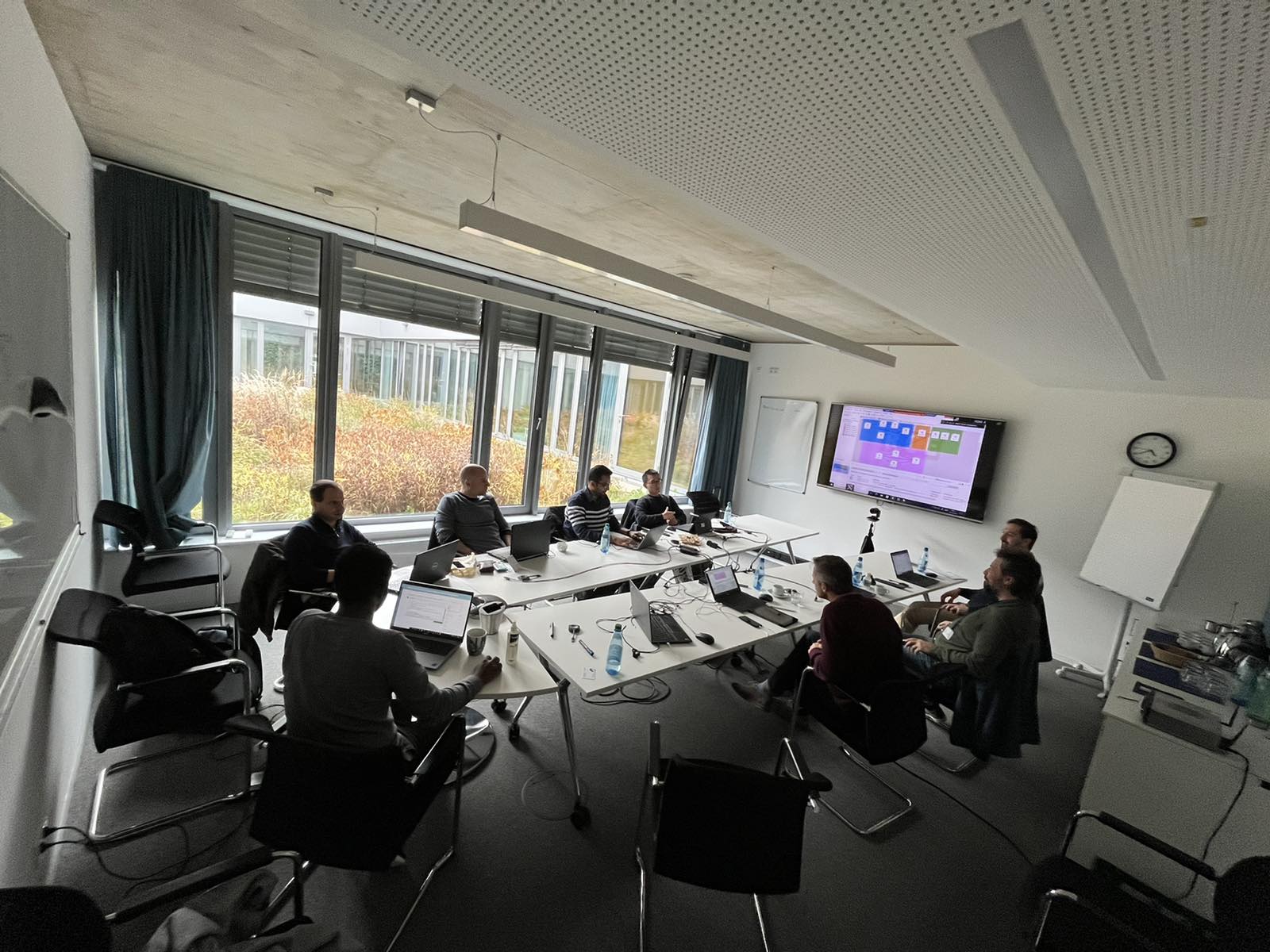
The developer team of SZTAKI had two visits at TUM in the last period. First time the integration and tuning of the flutter suppression Direct Drive actuator was investigated. The new, digital protocol based RC communication was tested with the Flight Control Computer and the telemetry system was also improved. On the second visit the Direct Drive integration was finished. The improved telemetry system was tested with the avionics and the high speed 4G telemetry was finalized as well.

Consortium meeting at Budapest
2022/10/12
A new consortium meeting of the FLIPASED project was organized in Budapest on October 11 and 12. Most of the partners were able to come to Budapest in person and the remaining researchers joined us online.
There were two main topics for discussion, the detailed rebuild and flight test plan of the demonstrator aircraft and the status and future goals of the multidisciplinary design optimization (MDO) toolchain. Progress was made in the following areas:
- Detailed airframe rebuilt plan in a Gannt chart from, specifying targets, deadlines and responsibilities for all partners
- Improvements in Hardware in the loop (HIL) tests in order to decrease the technology gap between the HIL tests and flight tests of the demonstrator aircraft
- Updated ground vibration tests (GVT) plans
- Flight test plan specifications for the active flutter suppression demonstration tests
- MDO tasks for the demonstrator and scale-up aircraft


T-FLEX accident
2022/08/31
At approximately 18:38 on 30th of August 2022, the T-FLEX, a remotely piloted experimental demonstrator used within the FLiPASED H2020 project, experienced an in-flight incident during a flight test segment at DLR's Cochstedt Flight Test Center. The encountered anomaly caused an impact to the ground. Due to adherence to the emergency response plan all the various data sources were recovered, such as the main log, transmitter logs and videos from all three cameras. Based on this data, an investigation will be made to find out the cause of the accident. There were no injuries or casualties.
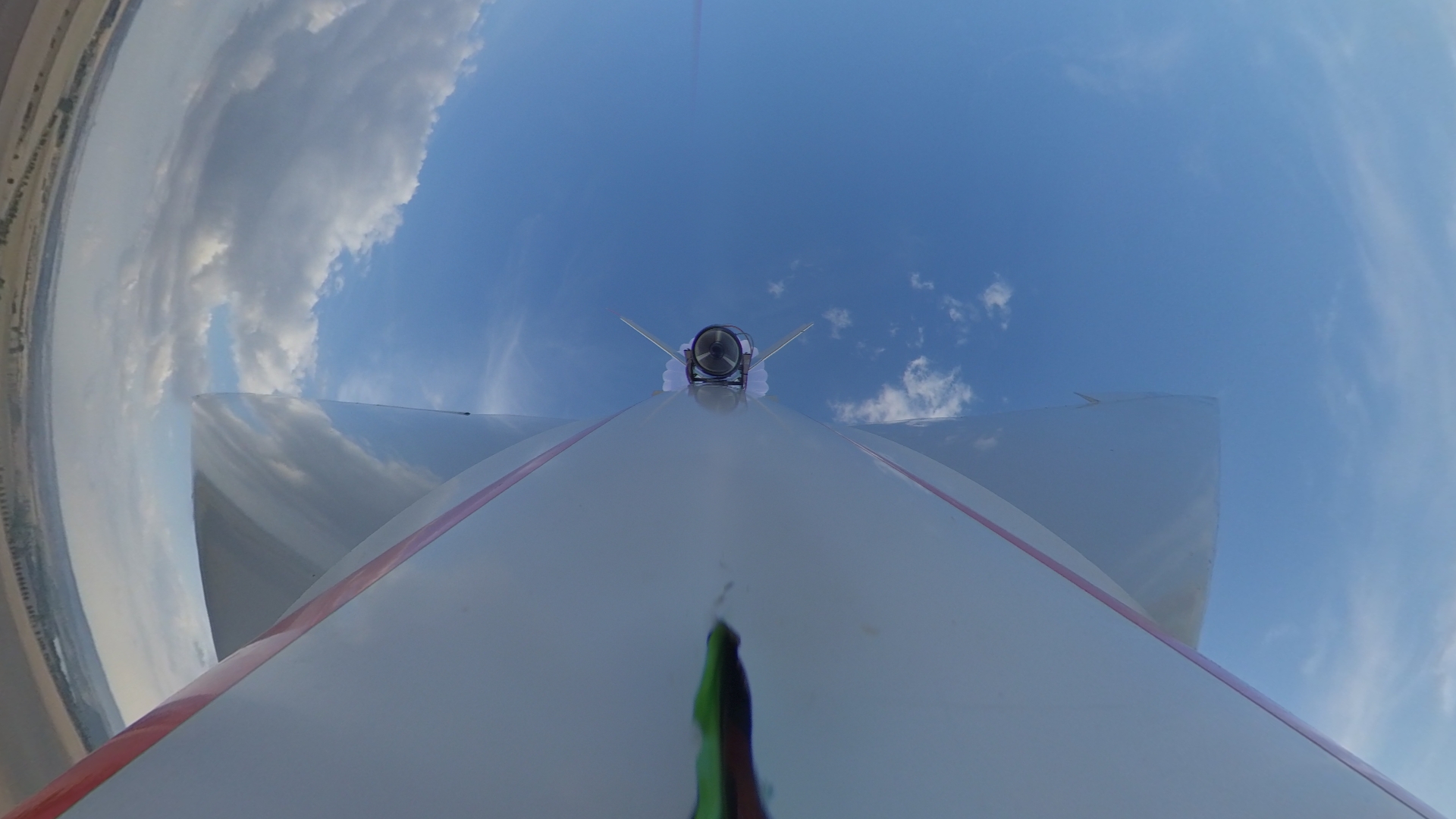
Flight test campaign #2 at DLR National Experimental Test Center for Unmanned Aircraft Systems
2022/08/25
The flight test team of TUM and the avionics engineering team of SZTAKI started to prepare the unmanned demonstrator aircraft called T-FLEX for flight tests at the test airport of DLR at Cochstedt. During the first few days they solved some minor issues and after successful taxi tests they managed the aircraft to the air again. In the first week pilot training flight tests happened and the basic functionalities of the autopilot were tested. In the second week DLR team joined the flight test team and started to perform the system identification flight tests.
Consortium meeting at Budapest
2022/07/14
After the long period of ONLINE MEETINGS only the FLIPASED consortium could finally meet in person.
The meeting was organised on the 4th and 5th of July in Budapest, at SZTAKI in hybrid format so also the members of the Scientific and Industrial Advisory Group could join us for the event on the 5th of July. The 4th of July was dedicated to bilateral in-person meetings.
Progress was achieved regarding the following topics:
- Analysis of the recent flight test campaign at DLR Cochstedt
- Preparation for the manufacturing and instrumentation of the newly built performance adaptive wing
- Schedule and objectives for the upcoming GVT (Ground Vibration Test) campaign, to be conducted at DLR in Göttingen
- Target for the next flight test campaign and the corresponding software, hardware infrastructure to be provided

Flight test campaign at DLR National Experimental Test Center for Unmanned Aircraft Systems
2022/07/10
In May 2022 we have flown, crashed, repaired and flown again the T-FLEX demonstrator, within the FLiPASED H2020 project. The project consortium has cleared several goals:
- We tested all the functionalities of the autopilot that will be required for flutter testing. This includes being able to follow a trajectory and also use autothrottle all the way up to around 56m/s, more than 10% beyond open-loop flutter speed.
- Gather flight data to identify the rigid body modes. During our last flight, 13 manoeuvres were injected for this purpose. Hopefully the data will be usable.
- Gather flight data to identify the flexible body modes and track them online. I believe the last few minutes of the last flight (storm conditions) provided enough vibrations in all directions for this purpose.
- Baseline aerodynamic coefficient determination including airbrake drag identification manoeuvres.
- Training time for the new pilots. Not as much as we wanted, but more than none.
- Visualization of airflow over the wings were done with tufts and oil experiments. Let's see what images we can extract from that.
- Airspeed calibration in-flight manoeuvres which hopefully will help quantify the errors from the air data system.
- Induced drag experiments, where we flew with flaps deflected for extra induced drag. Let's see if the effect can be extracted.
All this was done in 8 flights, during which we got around 140min of flight time.
Special thank you goes to Fabian Wiedemann, who piloted and repaired the aircraft when no one thought would be possible, Julius Bartasevicius who coordinated the whole test campaign, Christian Rieger and Thomas Seren who took their weeks off from other projects to help us pilot the T-FLEX, Daniel Teubl who was there for complete two weeks doing engineering work and Christian Rössler who landed the aircraft during a storm (10m/s+ gusty wind). The teams from SZTAKI (Institute for Computer Science and Control) and German Aerospace Center (DLR) also helped immensely with providing the test airfield, software preparation debugging and supporting the test team.
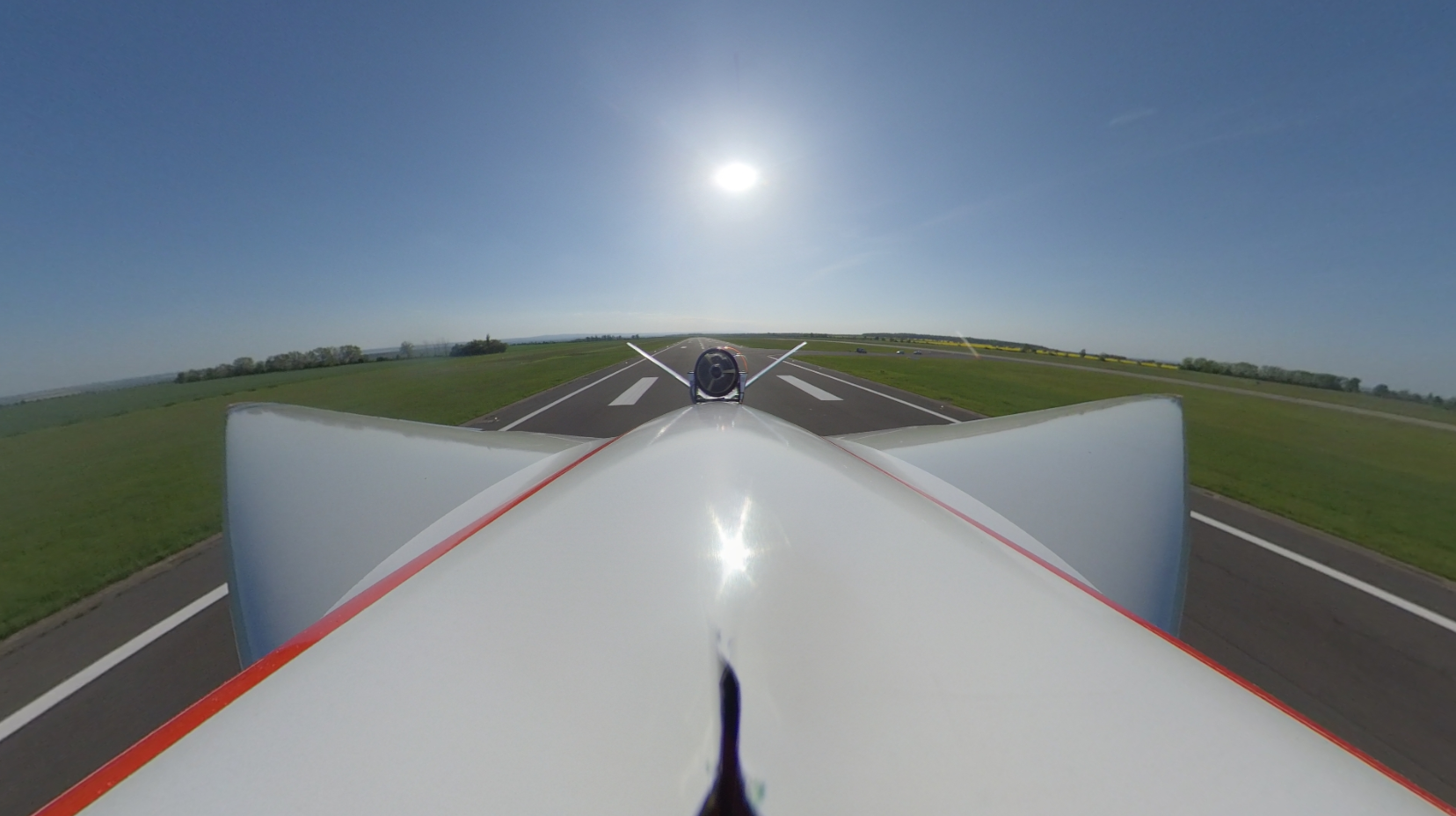
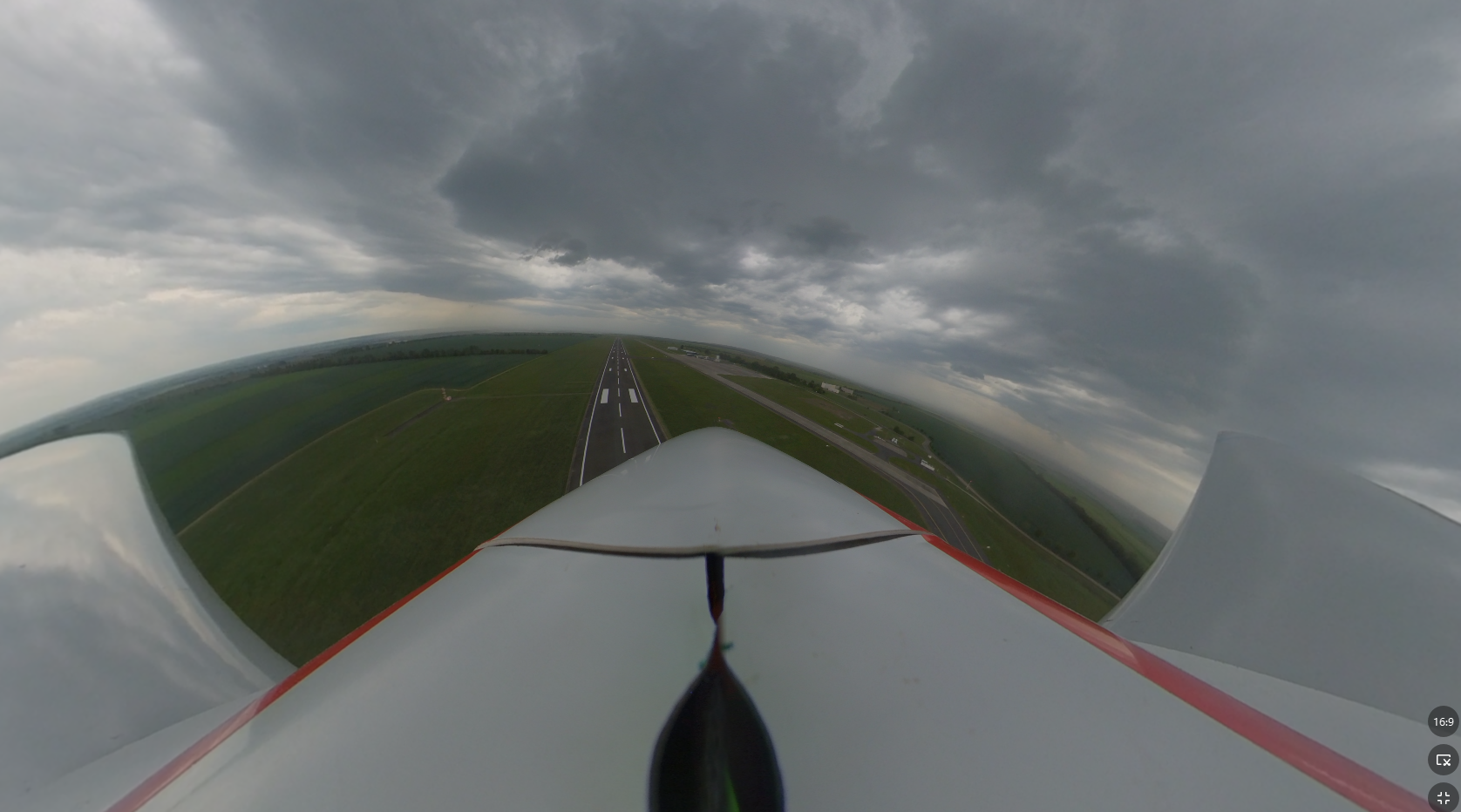
Flight test team training
2022/03/03
In preparation of the upcoming flight test season the new members of the flight test team are undergoing a training programme at TUM.
The training programme includes studying the Concept of Operations of the project, familiarising with the systems of the TFLEX UAV, learning the peculiarities of Engineer and Operator roles and, most importantly, training communication procedures in the simulator developed by DLR-SR.


Development of Online Flutter Monitoring System
2022/02/03
Development teams from DLR Göttingen, TUM, and SZTAKI have joined forces to develop a so-called Onboard Computer II (OBCII) for the T-Flex aircraft. The main task of the OBCII is to run online modal analysis scripts to estimate wing flutter data, like frequencies and dampings. Other tasks of the OBCII include acting as a host for external sensors such as the Thrust Measurement System and to maintain steady connection with the Flight Control Computer. The internal architecture of the OBC-II was designed to be orthogonal and scalable, so attaching and logging data from other sensors does not affect the setup of the other sensors. Successful testing was carried out on the actual aircraft and in HIL environment as well. The team is planning to publish articles in this topic during 2022.

Publication at ICAS conference
2022/01/14
Interested in how does the flight testing of the T-FLEX demonstrator look like? We have published a conference article about the topic at the ICAS conference last year. The article describes the flight test environment of the demonstrator by providing insight into the setup of the aircraft, its systems and flight surroundings. Special effort is made to explain the operational procedures and preparations required to safely perform the flight tests.
You can access the article here.
SciTech publication by DLR
2022/01/13
A Multiple-Model Adaptive Controller for Gust Load Alleviation has been synthesised for the demonstrator aircraft. It will be especially useful for the scale-up task when different fuel tank levels have to be considered.
An accessible author's version can be found at DLR's electronic library elib.
Thrust Measurement System was presented in SciTech 2022 conference
2022/01/10
A thrust measurement system is the latest addition to the measurement capabilities of the T-FLEX demonstrator. The system will be especially useful while measuring testing the different mechanisms to reduce the induce drag in-flight.
The design and testing of the system was presented in the AIAA's SciTech 2022 conference and can be found here.
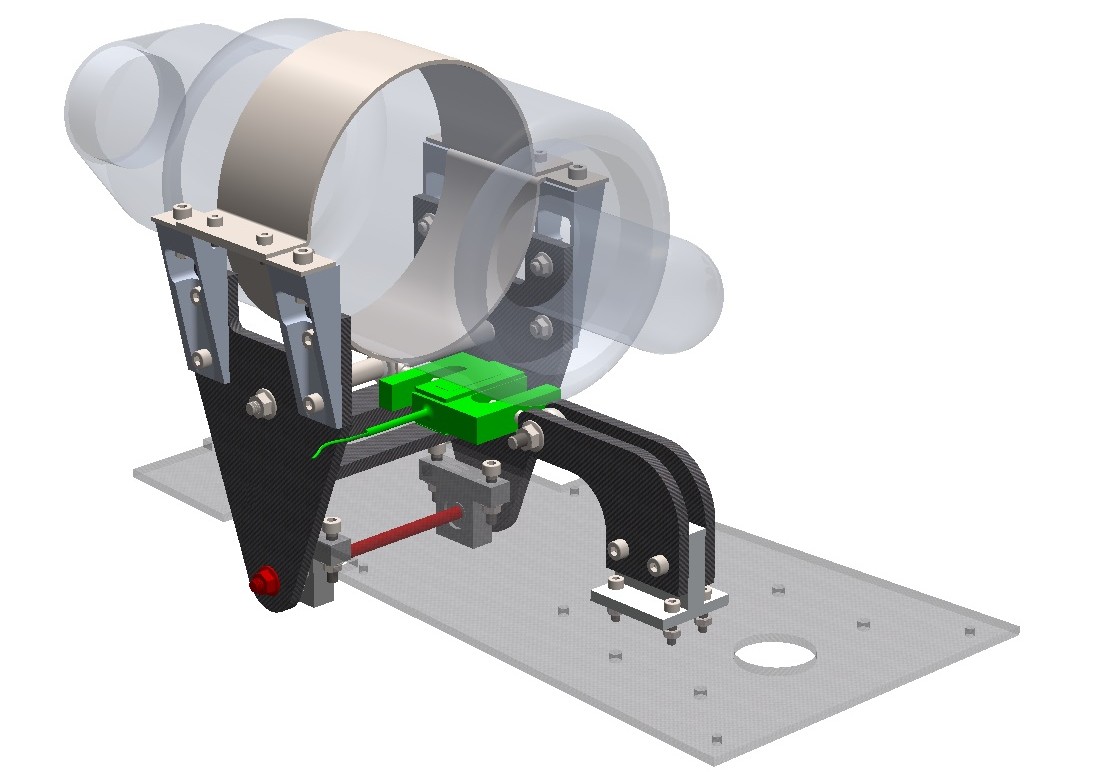
Thrust Measurement System CAD model
DirectDrive integration at TUM
2021/11/26
This week SZTAKI team visited TUM in order to integrate the DirectDrive actuator to the T-FLEX aircraft's flexible wing and perform regular flight control computer updates. Because of the pandemic, we ensured a safe work environment with daily rapid testing at TUM facilities and by using FFP2 masks in the lab.
We have successfully tested SZTAKI's custom-developed servo actuator which will be responsible for flutter suppression using the outermost ailerons. This is the DirectDrive which can be seen in the picture below.

DirectDrive on the wing
In the video, we can see the actuator driven by the RC controller, and some diagnostics information are also shown. The actuator will be controlled by the new "RXMUX2" board after the sub-scale flight tests with SZTAKI's Sindy platform.
We also performed software updates on the Inertial Measurement Unit system inside the wings, upon findings of DLR - to improve operational modal analysis performance. Therefore, their onboard modal identification algorithms can be improved. Further feature requests between the developer teams were also discussed to improve the onboard electronic systems. The lessons learned from recent flight tests were shared with each other.
The trip was considered a success since we got closer to the -1 flutter wing's flight test and the demonstration of active flutter suppression to expand the flight envelope.
Cross verification of the FLiPASED avionics for safety!
2021/11/16
On 16th November 2021. few days after the T-FLEX aircraft of EU H2020 Flipased project was flown again in Münich (see below) the researchers of SZTAKI did various flight tests in Papkutapuszta, Hungary on a different UAS platform (rigid wing, dual engine) called Sindy with the same onboard system developed in frame of the Flipased project. Besides the common onboard software and hardware architecture the two aircraft shares the same ground control station and telemetry channels, so the two remote flight test crews - at TUM in Germany and at SZTAKI in Hungary - can share lessons learnt and test solutions without the need of physical presence at the same location. Direction, velocity and altitude hold functions were successfully flight tested as shown in the video. The next step will be the test of the brand new 2nd generation Multiplexer board "RXMUX2" on Sindy before application on T-FLEX.

Sindy aircraft
Flight Test 8 for T-Flex
2021/11/10
On Wednesday, November 10th , the T-FLEX demonstrator took off for another flight to familiarize the new primary pilot with the aircraft, test autopilot functionality and conduct experiments for identifying the turbine dynamics. Even though the flight was conducted in less than ideal conditions in terms of visibility that prevented the usage of the flight box to full extent and revealed the necessity of refining the autopilot’s stabilized mode, valuable data for the refinement of the autopilot software and thrust measurement system was collected. Furthermore, the flight built further confidence in piloting and operating the aircraft: The new flap configuration for take-off, that was implemented for Flight Test 8 after testing it on the dynamically scaled demonstrator “DeFStaR”, facilitated the critical start run by lowering the required airspeed for lift-off and was trimmed in flight. Finally, T-FLEX landed safely after an uneventful approach.
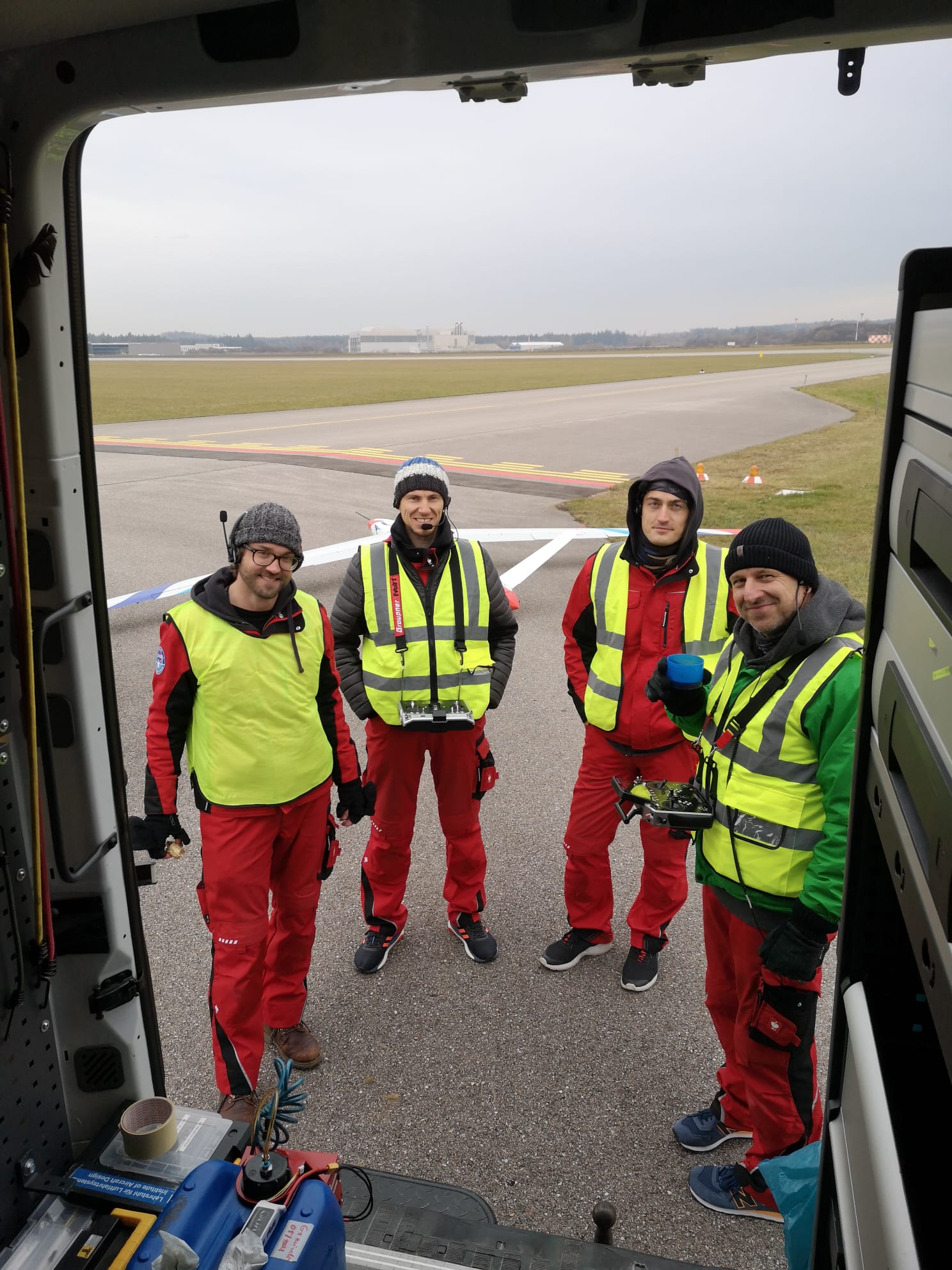
Flight test team, with the demonstrator in the back
First personal meeting at TUM after COVID travel restrictions
2021/10/15
After 20 months of online work (due to COVID-related travel restrictions) our consortium has finally met in person at TUM Münich. What a difference the face-to-face occasion makes!
- We have updated the wing design objectives for the aeroservoelastic design toolchain
- Based on the new performance criteria for MDO optimisation we refined the objectives of the flight test campaign
- The basis for scale-up (D150) and the corresponding tools have been discussed
- TUM showed the 50% scaled down version of the demonstrator called:„DeFStaR” – with which they performed stall tests.
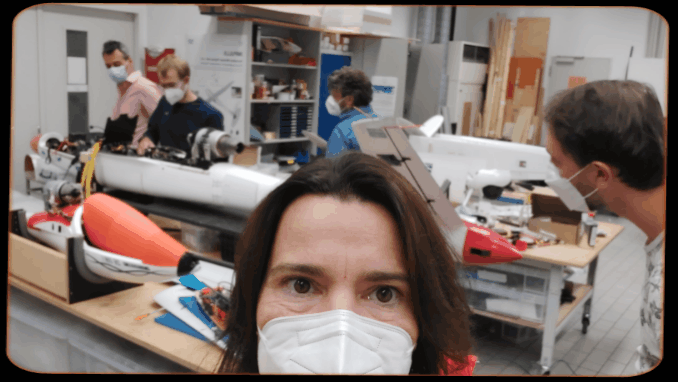
SZTAKI, Hungary, leading EU research on active control of aero-elastic aircraft wings
2019/09/13
H2020 project FLIPASED was launched officially on Thursday
Researchers of SZTAKI, Institute for Computer Science and Control, Hungary, will lead the international project FLiPASED (FLight Phase Adaptive Aero-Servo-Elastic aircraft Design) which intends to revolutionize aircraft wings through developing and testing the so called active-controlled wings. Besides the coordination of the project, to be managed by Bálint Vanek, SZTAKI will work on the fields of control theory and aircraft design in a multidisciplinary environment in order to tighten the connection between the physical configuration of aircrafts and their on-board flight control algorithms.
Participants
The partners participating in the project are the Technische Universität München (TUM), the Deutsches Zentrum für Luft- und Raumfahrt (DLR), the Office National d'Etudes et de Recherches Aérospatiales (ONERA) and the project coordinator Institute for Computer Science and Control (SZTAKI).
Finances
The project is completely financed by the European Union. The 3,846,245 € budget is provided by the European Union Horizon 2020 Innovation Programme. This sum is divided among the participants as follows. SZTAKI receives 1,066,875 €, TUM 1,235,375 €, DLR 941,495 €, and ONERA 602,500 €.
The research problem
By today, the wing and propulsion system technology of modern aircrafts has reached the peak of its effectiveness. For both the Boeing 787 and Airbus A350 composite materials account for more than 50 percent of the total weight. Meanwhile, more than 25 percent of the operational costs of commercial airlines is spent on fuel, therefore, more efficient fuel consumption is an important question from both environmental and financial perspectives.
Aircrafts require the proper ratio of drag and lift forces in order to handle varying flying conditions. The goal of the aircraft manufacturers is to reduce drag and save fuel accordingly. This is achieved by a very high degree of slimness (high aspect ratio) of the wings, built from composite materials which are more and more flexible and deformable. However, the wings of the aircrafts are designed to achieve minimal drag only under a single flying condition, determined by the weight, speed, height and range of the aircraft. In varying conditions, the fine-tuning of the aerodynamic surfaces is required to change the lift-drag ratio, however, with the currently available airbrakes and other control surfaces only a rather rough modification can be achieved.
The solution
In contrast to previous solutions, the shape of active-controlled, flexible wings can be fine-tuned and they can adapt to various flying conditions. The aim of the airlines is to reach their destinations in the straightest path, and in order to accomplish this, they would fly even through more turbulent conditions (which are more frequent due to the climate change) as well. With conventional rigid wings passengers experience these turbulences more strongly, while with the methodologies developed in the project the flexibility of the wings and the active control together ensure the reduction of physical loads for both the aircraft and passengers. In a same way, different wing shapes can be chosen for take-off and landing, in order to achieve the most comfortable and efficient flying experience.
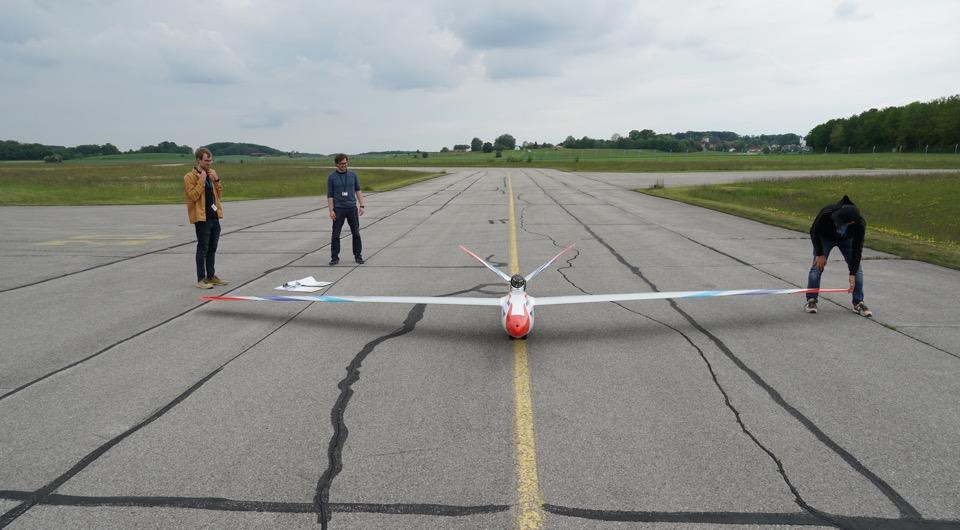
The unmaned aircraft developed for research purposes in the FLEXOP H2020 project, the predecessor project of FLiPASED
Based on the current research results, the effect of wind gusts can be reduced by 20 percent with active wings. The fuel consumption can also be reduced by 10 percent with changing the wing shape during the flight path and with the consequent reduction of the drag force.
Big Data
More than 500 parameters are measured two hundred times a second on the experimental aircraft, producing a large amount of data (1,5 GB raw data per hour). The Informatics Laboratory of SZTAKI headed by András Benczúr will also participate in the project: processing the data would enable the fine-tuning of the optimal wing shape settings for aircrafts, as the optimal parameters may differ for various aircrafts and also vary with the aging of the materials even for a single plane itself.
Industry
The goal of the project is that the results of the research to be obtained by the end of 2022 be applied in practice within a 5 to 10 year period. Therefore, the industrial partners of the project’s advisory board are the world leading airliner manufacturer Airbus Operations SAS, the military and space flight expert Airbus Defence and Space and business jet and autonomous drone specialist Dassault Aviation. The results of the project will be tested not only in simulation but also demonstrated using a 7-meter-wingspan experimental unmanned aircraft built for research purposes.
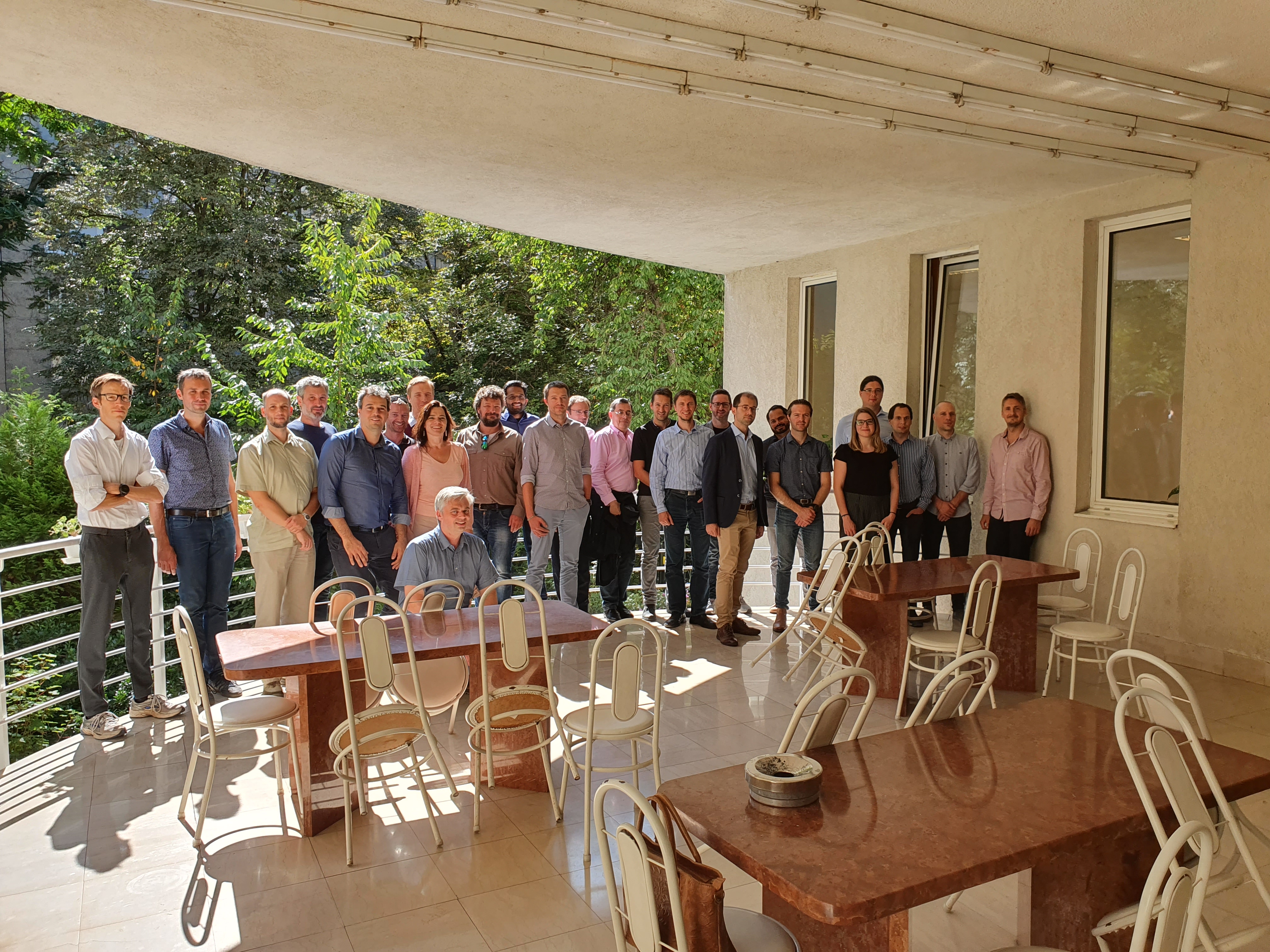
Participants of the kickoff meeting (not in order):
SZTAKI: Bálint Vanek, Virág Bodor, András Benczúr, Tamás Luspay Béla Takarics, Péter Bauer, Laszló Gyulai, Szabolcs Tóth, Réka Mocsányi, Bálint Patartics, Tamás Baár, Csaba Sidlo, Zoltán Szabó, Tamás Péni, Márton Farkas. ONERA: Charles Poussot-Vassal, Pierre Vuillemin, Arnaud Lepage. DLR: Thiemo Kier, Gertjan Looye, Johannes Dillinger, Yasser Maddaikar. TUM: Andreas Hermanutz, Christian Rössler. Airbus IAG: Carlo Aquilini, Sebastien Blanc. Dassault IAG: Broux Gabriel, Cantinaud Olivier. Technical University of Delft: Roeland de Breuker.

